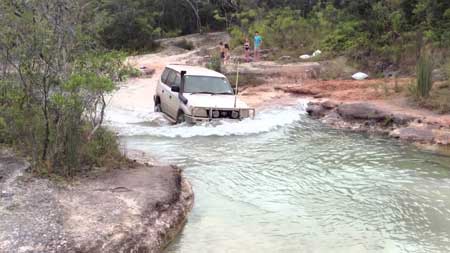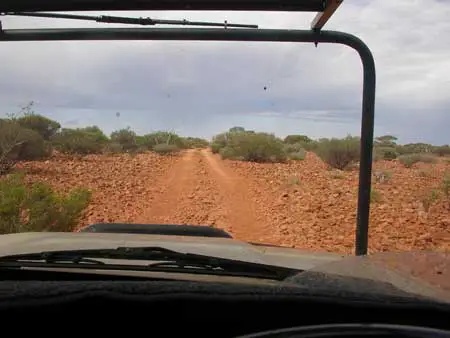Don’t choose something that is too big, but don’t buy a unit so small that you will overload it. Small vehicles can often access areas that are inaccessible to large vehicles. They are also easier to park. Small, light vehicles, have advantage on beaches and soft ground. On the other hand, larger vehicle can carry heavier loads and pull large trailers or caravans. Large four-wheel drives include Toyota Landcruiser, Nissan Patrol, Land Rover and Range Rover, Medium four-wheel drives include Ford Explorer, Mitsubishi Pajero, Holden Jackeroo and Holden Rodeo, Toyota Hilux, Nissan Pathfinder and Land Rover Discovery. Small four- wheel drives include Suzuki Sierra, Daihatsu Rocky, Toyota Rav4 and Land Rover Freelander. Units such as the Subaru Forrester and Liberty, four-wheel drive Corolla and some Honda vehicles are referred to as sedan four-wheel drives.
Choices include forward control or a conventional bonneted vehicle, a station-wagon, a ute with a tray back or hight sided with or with out a canopy. A dual cab tray is to sort to sleep in, but it will be fine if you need to carry five passengers and some firewood as well, for couples, the extra-cab or king cab version of utilities offer more cabin space, a storage area for valuables and much improved seating . For those people that are wondering what is a forward control vehicle, it is like some of the combies buses such as a Toyota where you sit close to the windscreen.
If you intend carrying back-seat passengers, don’t be fooled by the overall size of a vehicle some back seats aren’t roomy (look for intruding wheel arches) or comfortable. Remember to try before you buy . When you’re travelling over rough roads, snug seats with good head, thigh and lateral support are invaluable, and plenty of space above the head is a bonus.
More power requires more fuel. If you need to pull a horse float, caravan then power may be an issue, otherwise you might be better off with a less powerful vehicle. While a more powerful four-wheel drive generally has a larger fuel capacity, your running costs will be higher.

More clearance- the distance between the surface and the lowest point of the vehicle- means less chance of the underside components striking the ground All designs bring benefits as well as limitation: a low centre of gravity gives High stability, but reduces ground clearance; high clearance means grater risk of topping over, but the ability to travel over boulders and through gullies. Several factors alter the ground clearance. One is the wheel diameter; little Wheels usually means little ground clearance. Another is the style of suspension Clearance is also affected by the profile of the tyres. There is four kinds of clearances that should be checked.
VEHICLE’S LOWEST POINT – The lowest point is usually the differential housings of one of the axles, or the protective bash plate under the engine area of the smaller vehicles.
RAMP-OVER ANGLE – This is important when going over ridges-short wheel base (SWB) vehicles have better ramp-over angle performance than long wheelbase (LWB) vehicles.
APPROACH ANGLE – This describes the steepness of approach surfaces that the vehicle can manage Poorly fitted bullbars and nose overhang are detrimental to the approach angle.
DEPARTURE ANGLE – What you don’t see behind you can cause harm. Tail overhang, sagging or flattened suspension from overloading, and low towbars are all likely to contact the surface. Although rarely thought about, the departure angle is extremely important if you are trying to back out of a bog or into a gradient.
(petrol / diesel / duel fuel) Petrol engines are very responsive and yield more power than LPGas (autogas) or diesel, but petrol is explosive and vaporises at high temperatures. It is almost universally available in leaded and unleaded forms; some remote seyylements only sell unleaded petrol, but many of these offer avgas (aviation fuel) as a substitute. Dual fuel – petrol/ LPGas installations offer economical travel if you cover distances long enough to result in savings that will overcome the costs of installation.
The down side of dual fuel is that LPGas is not always available. Sometimes dual fuel installations accommodate the gas cylinder by replacing the original fuel tank with one of a smaller capacity, thus limiting your rang when away from gas supplies. Outback travellers should avoid gas installations that use rigid copper lines: these fracture with body flexing. Note that autogas is not the same type of LPGas as that used in cooking, lighting and heating appliances.
Diesel is the most common fuel used in the outback. It will not ignite quite readily, so it is safe than petrol or gas. However, because of acid formation, a by-product of combustion, diesels need more frequent oil changes. They also need frequent fuel-filter changes – especially if it form 200 litre drums – and better preventive maintenance than petrol engines.
In water crossings, petrol engines are soon affected by spray and moisture unless extensively prepared, but if water is ingested into a petrol motor it usually survives the ordeal and can be returned to service without a lot of trouble. On the other hand, although a diesel motor is not stalled by water mist or vapour, direct entry of water can sometimes mean dismantling and replacing items such as pistons or connecting rods – not an everyday roadside repair.
There is a reluctance on the part of those who live in the real outback to buy modern petrol four-wheel drive vehicles fitted with computer-managed electronic fuel systems – this is because the petrol management fuel system is not serviceable on the road side if they fail. The fail rate for these systems is quite low, but you may be a long way from anywhere on a rarely used track in the event that the vehicle does fail.









